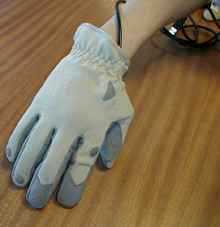
A new glove lets soldiers operate wearable computers while still holding their weapons.
Some U.S. soldiers in Iraq are already equipped with wearable computer systems. But the lack of efficient input devices restricts their use to safer environments, such as the interior of a Humvee or a base station, where the soldier can set down his weapon and use the keyboard or mouse tethered to his body. Now RallyPoint, a startup based in Cambridge, MA, has developed a sensor-embedded glove that allows the soldier to easily view and navigate digital maps, activate radio communications, and send commands without having to take his hand off his weapon.
For soldiers carrying a plethora of equipment, finding and using electronic controls on their bodies can be awkward, says Forrest Liau, the president and cofounder of RallyPoint. "We wanted to make a device that would have all the necessary components in a combat-ready way," he says. The Natick Soldier Systems Center in Natick, MA, has a contract with RallyPoint and is currently testing a prototype of the glove, called a Handwear Computer Input Device (HCID), for use with its electronic systems.
A sensor-laden glove for wearable computing is not an entirely new concept. Researchers at MIT, the University of Toronto, and the Georgia Institute of Technology have been working on systems that focus on detecting hand and arm movements by using accelerometers, gyroscopes, and other high-tech sensors. But Gerd Kortuem, an assistant professor of computing at Lancaster University, in England, says that most of these prototypes "don't work reliably and are not robust enough." Microsoft and Sony have also worked on gesture recognition and wearable-mouse technologies, but their research has yet to yield usable devices.
RallyPoint has a "very clever design and has actually created something practical by focusing on a particular domain--the military," says Kortuem.
A typical wearable computer system consists of a helmet-mounted display and hardware the soldier wears around his waist. RallyPoint's engineers have designed their glove so that soldiers can grip other objects, such as their weapons or a steering wheel, and still be able to use their electronic systems. The glove has four custom-built push-button sensors sewn into the fingers. Sensors on the tips of the middle and fourth fingers activate radio communications, a different channel for each finger. Another sensor on the lower portion of the index finger changes modes, from "map mode" to "mouse mode." In map mode, the fourth sensor, located on the pinky finger, is used to zoom in on and out of the map; in mouse mode, it serves as a mouse-click button.
Also sewn into the pad of the middle fingertip of the glove is an "anywhere mouse" that uses force sensors and acts as a track pad. "When a soldier presses down against the side of his weapon, a wall, or any hard surface and rolls his finger around, he can manipulate things on the screen," says Liau.

Technology Review
01.05.2008